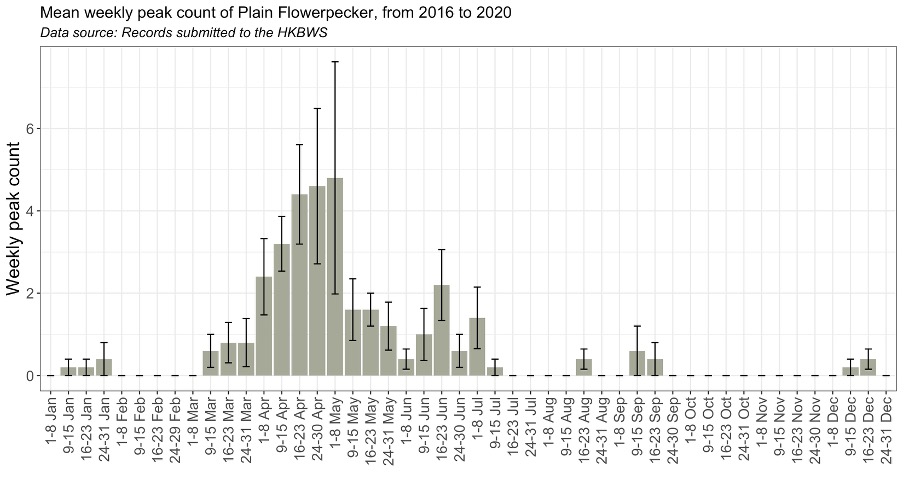Plain Flowerpecker Dicaeum minullum 純色啄花鳥
Category I. Scarce but increasing summer visitor to forest or forest-edge, primarily recorded in song in spring; it is rare in autumn and winter.
IDENTIFICATION

Apr. 2019, WONG Wong Yung.
7.5-9.0 cm. Drab, plain flowerpecker, olive-tinged brown above, off-white below with plain lores and decurved short bill with paler base to lower mandible.
VOCALISATIONS
The song is a rapid series of thin notes that quickly increase in pitch over the first few notes.
Also utters a single or double note calls, the second element of the latter being higher than the first. Occasional short buzzing calls may also be given.
The ‘chik’ call common to many Dicaeum spp. may be heard in flight or as a repeated series of notes. It is lighter than other flowerpeckers in HK and may even suggest Dusky Warbler.
DISTRIBUTION & HABITAT PREFERENCE
A high proportion of records in the period to 2011 were from shrubland with few from forest or fung shui woods favoured by the other flowerpeckers. However, since 2016, the period in which a breeding population appears to have established, most records have occurred in mature forest at Tai Po Kau or at forest edge in Lam Tsuen. This contrasts with the situation during the breeding season at Ding Hu Shan Reserve, Guangdong, and on Hainan, where this species occurs primarily in shrubland or disturbed village-edge woodland rather than the adjacent primary broadleaf forest (GJC pers. obs.).
OCCURRENCE
Plain Flowerpecker was first recorded in HK when a pair was found nest-building at Ho Sheung Heung near Sheung Shui on 2 April 1988 (Cooper 1991). Unfortunately, they were not seen after this date, and it is not known whether breeding was successful. By 2001 there were a further 17 records, after which there was a gap of eight years. There were then four records in the period 4 December 2009 to 30 October 2011, followed by another gap of nearly five years. Since 13 April 2016 however, Plain Flowerpecker has increased substantially, with records on 13 dates in 2016, 11 dates in 2017, 18 dates in 2018, 27 dates in 2019 and 47 dates in 2020.
There has also been a change in the pattern of occurrence. Of the 23 reports up to 30 October 2011, all bar three were in the non-breeding season, with both autumn passage migrants and winter visitors apparently involved. In contrast to the other flowerpeckers, which are rather scarce away from the mainland, seven of the records up to 1998 were from islands, further indicating the occurrence of true migrants. However, since 2011 less than 10% of reports have occurred in the period July to February, with little suggestion of autumn passage. As Figure 1 shows, it is now generally recorded in spring when birds are often in song.
There is a record of a bird being fed by an adult during 10-11 May 2017. It seems likely, however, that the first nest-building episode was the consequence of a chance meeting of wintering birds rather than the initial establishment of a breeding population, which does not seem to have occurred until 2016.
BREEDING
The first record involved a pair nest-building at Ho Sheung Heung near Sheung Shui on 2 April 1988 (Cooper 1991). This remained the only evidence of breeding until 10-11 May 2017 when a chick was observed being fed by adults of Plain Flowerpecker and Fork-tailed Sunbird on the first date, and by an adult Plain Flowerpecker on the second. Despite the upsurge in records since 2016, this remains the only recent evidence for breeding, though birds are regularly reported in song.
BEHAVIOUR, FORAGING & DIET
Like other flowerpeckers in HK, it has been seen foraging on Oriental Mistletoe Viscum ovalifolium. When in song, it is more likely to occupy high, exposed perches on taller trees.
RANGE & SYSTEMATICS
Occurs from the Himalayas east to south China and south through Indochina, Thailand, Malaysia and Borneo to the Greater Sundas as far as Bali (Kirwan and Boesman 2021). In China occurs in southern coastal provinces including Hainan and Taiwan, as well as Yunnan and southwest Sichuan (Liu and Chen 2021).
Five subspecies are recognised, of which three occur in China. The taxon occurring on the mainland, including HK, is D. m. olivaceum, while D. m. uchidai occurs on Hainan and the nominate taxon in Taiwan.
CONSERVATION STATUS
IUCN: Least Concern. Population trend decreasing.
Figure 1.

Cooper, G. (1991). Plain Flowerpecker at Ho Sheung Heung: the first record for Hong Kong. Hong Kong Bird Report 1990: 117-118.
Kirwan, G. M. and P. F. D. Boesman (2021). Plain Flowerpecker (Dicaeum minullum), version 2.0. In Birds of the World (B. K. Keeney and P. N. Maleko, Editors). Cornell Lab of Ornithology, Ithaca, NY, USA. https://doi.org/10.2173/bow.plaflo2.02
Liu, Y. and S. H. Chen (eds) (2021). The CNG Field Guide to the Birds of China (in Chinese). Hunan Science and Technology Publication House, Changsha.

